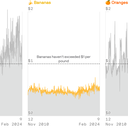Bananas: One of the few items untouched by inflation

Soaring food prices have taken a serious bite out of consumer spending, but there's at least one item that's consistently bucked the trend: bananas.
Why it matters: The U.S. imports more bananas by volume than any other country, according to the Food and Drug Administration. Despite their popularity, bananas are significantly cheaper than their peers in the fruit world.
- With the highest per capita availability (a proxy for consumption) at 26.9 pounds per person, bananas' popularity has defied the grip of food inflation.
Between the lines: Favorable growing conditions, low labor costs, efficient shipping and distribution, free trade agreements and massive plantations have insulated this particular fruit from the ravages of soaring prices.
What they're saying: Bananas' status as a "poor man's luxury" and the absence of tariffs contribute to their affordability, according to John Soluri, a history professor at Carnegie Mellon University. He's also the author of "Banana Cultures: Agriculture, Consumption, and Environmental Change in Honduras and the United States."
- Soluri explains that banana prices stay low because most of the processing is done in low-wage tropical areas; since they spoil quickly, growers move them fast, often selling them at any price.
- Luis Ribera, a professor and economist at Texas A&M AgriLife Extension Service tells Axios that almost all bananas in the U.S. are imported. "When you look at the cost per unit produced, then it is fairly cheap in comparison to other fruit and vegetables. Consumers benefit from that."
Flashback: Since 1961, the U.S. has been the top importer of fresh bananas by volume.
- At one time Ecuador was the leading banana exporter for the U.S. but Guatemala now accounts for approximately 41 percent of U.S. banana imports.
By the numbers: The average monthly price for a pound of bananas is 62 cents in January this year— cheaper than other grocery items such as lemons ($2.08), grapefruit ($1.71) and oranges ($1.55).
- The tropical fruit is below the average global price of 73 cents per pound in January and has been priced for under a buck for decades.
- According to Federal Reserve data, with a PCE price index inflation rate of 2 percent, it could take 210 years for a banana to reach a price of $10.
Fun fact: The average price of bananas has never exceeded 80 cents per pound since 2004, according to the recent data from the International Monetary Fund (IMF).
- At Trader Joe's, bananas have stayed at 19 cents apiece since the 2000s. You can even get one for free near Amazon's headquarters.
- As a major traded fruit in terms of export value, banana forms the cornerstone of many countries' economies, small-scale farms and large plantations.
There are just a handful of places in the U.S. where bananas could probably be produced.
- "But just because we can doesn't mean that we should because other countries, Mexico or mainly Central America, are a lot more efficient at producing such products," Ribera tells Axios.
Friction point: A deadly fungus and fallout from climate change has threatened the supply of Cavendish bananas, the only type the U.S. imports. Ribera says research on how to contain the fungus hasn't been very effective.
- "But unlike oranges, bananas are perennial so if a supply adjustment to a new disease-resistant Cavendish variety had to be made, it would happen a lot faster than oranges," Ribera adds.